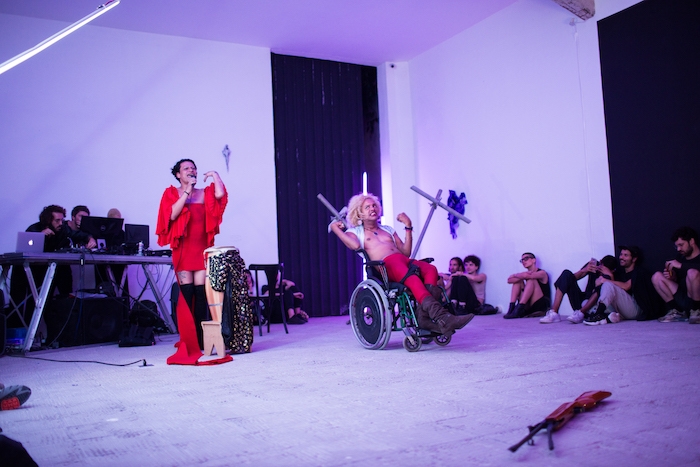The torrential rain that broke the plus-thirty Celcius São Paulo weather last Tuesday put a halt to my plans to head out on Avenue Paulista to attend one of the regular protests against Brazil’s far-right president, Jair Bolsonaro. The latest calamities to anger left and liberal Paulistanos include the never-ending series of apparent coincidences that put the alleged murderers of Rio councilwoman Marielle Franco in the vicinity of Bolsonaro’s apartment block prior to his election and her assassination, together with the leader’s son’s suggestion that if the left continues to ‘persecute’ the president then a ‘new’ AI-5 would need to be instituted, referring to the notorious 1968 law that ushered in the darkest days of the military dictatorship’s censorship and suppression of rights. Pictures sent by less fairweather friends at the protest showed a few hundred hardy souls listening to speeches while sheltering under the canopy of the Museum of Art of São Paulo.
The gallery was lit only by a series of neon bars, giving it the appearance of a nightclub
Closer to my apartment, the same night, or rather the next morning – the event started at midnight – was a three-hour programme of performances, installations and actions at Galeria Jaqueline Martins (so, indoors). The venue is among the most interesting commercial galleries in the city, but Beginning of a Century was a decidedly non-saleable venture. Curated by artist Germano Dushá alongside Guilherme Teixeira, the gallery was lit only by a series of neon bars, giving it the appearance of a nightclub more than anything else: a vibe completed by sound artist thingamajicks with his laptop, mixing desk and theremin and an introductory set by the latex-alien-masked musician Naves Cilíndricas (but no bar, so the neighbouring botecos had good takings that night). These were complemented by sculptures and wall works including a rotating mannequin by Ana Mazzei, a photograph of a young woman gouging her eye by Castiel Vitorino Brasileiro and a CGI video by Vitória Cribb, in which a purple humanoid form melts and transforms shape on a loop. Bodies – in flux or as sites of social disruption or political contention – were the overriding focus of the night.
A work by Dushá himself opened the performance programme, in which two professional basketball players skirmished over a ball and hoop. Their very tall bodies dominated the gallery – a command for our attention, a performance of anger – the aggression of their contact going beyond the usual gameplay. There was a sense of danger too – especially for a correspondent as contact-sport adverse as this one – as the basketball bounced hard across the room, centimetres from the surrounding audience. Likewise, the following live work, in which a balaclava-wearing and black-clad group, led by Deyson Gilbert, assembled a massive, precarious construction from neon tubing, metal bars, an upturned bench and blocks of ice (in which holes were drilled at one point) overseen by two figures wielding, respectively, a shotgun and a truncheon, felt equally likely to end in injury. The link between organised crime and the construction industry here is a much-reported one (and was one facet of the recent massive anti-corruption probe Operation Carwash), yet this was a work in which the audience’s bodies were put in seeming danger (at least the bodies of those who, like me, were near the front when the whole thing collapsed). This kind of potential physical endangerment might be rare for me, as a white male, but is a feature of everyday life for the performers from Grupo MEXA, a collective formed in 2015 of predominantly black trans and LGB artists, theatre makers and activists. Not that there was any victimhood on display here: instead, in the neon light, they sang, moved and danced together and in solos (of particular note were the stripping/singing turn by Barbara Brito and dance work by wheelchair user Anita Silvia).
There was a sense of danger too – especially for a correspondent as contact-sport adverse as this one
There is mileage for Bolsonaro in the culture war he has instigated against communities such as these: last week Roberto Alvim, the recently appointed secretary of culture, announced his brief in typically loopy fashion. ‘Like the Crusaders,’ he told Associated Press, ‘We are fighting barbarian invasions against the principles and values of our Judeo-Christian civilisation.’ Mostly, it is better not to engage in the trolling. Saying outrageous things against minority groups deflects press attention from the government’s systematic and, as has been alleged, criminal, failings, while talk of God and family appeals to the country’s strong evangelical Christian voter base. Yet my time felt better spent with these performers than at the protest on Paulista. There was nothing hectoring about Dushá and Teixeira’s event – and the audience was as mixed in identity as those performing, a rarity in art events globally – but it provided a coming together of bodies which the present Brazilian administration has in its crosshairs. Marielle Franco, a fervent critic of the president, was black, gay and from a favela; events like this one carry on her legacy.
16 November 2019
